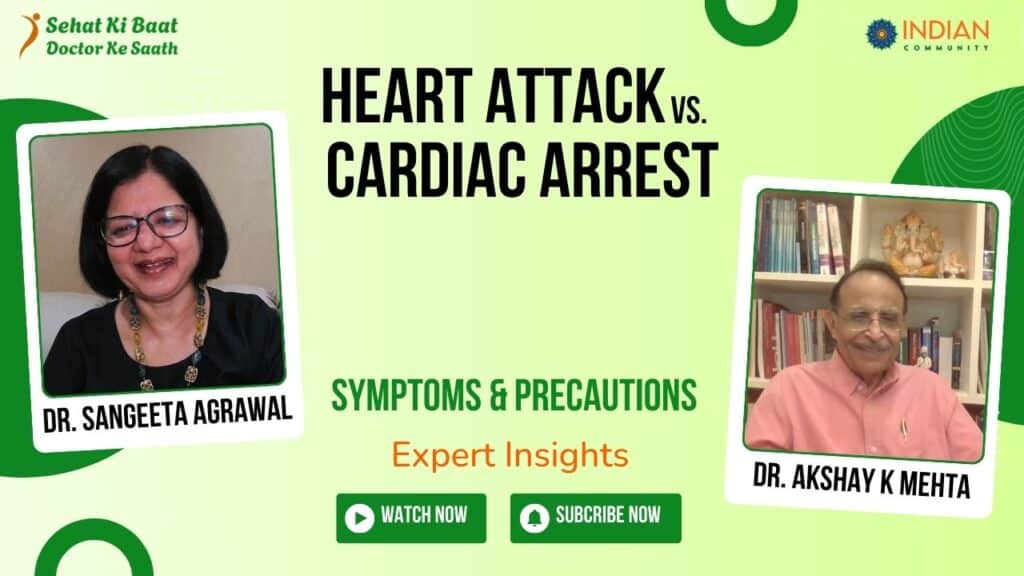In recent times, there has been a significant rise in cases where young individuals, aged 40-50, suddenly collapse while performing routine activities like morning walks. Unfortunately, many of these incidents lead to fatal outcomes. The primary question that arises in such scenarios is whether these cases are due to a heart attack or a cardiac arrest. Understanding the difference between the two is crucial as the immediate response varies for each condition.
To provide clarity on this matter, we turn to insights shared by Dr. Akshay K Mehta, a consultant cardiologist associated with Nanavati Hospital and Holy Family Hospital, Mumbai.
Table of contents
Heart Attack vs. Cardiac Arrest: What’s the Difference?
While both conditions are related to the heart, they are fundamentally different in terms of causes, symptoms, and emergency responses.
What is a Heart Attack?
A heart attack (myocardial infarction) occurs when there is a blockage in one of the coronary arteries, restricting blood flow to the heart muscle. The key symptoms of a heart attack include:
- Chest pain or discomfort (can be mild at first but worsens over minutes)
- Heaviness or tightness in the chest
- Sweating, nausea, and dizziness
- Pain radiating to the left arm, jaw, or back
- Shortness of breath
Immediate Action: If someone is experiencing symptoms of a heart attack, the best course of action is:
- Call an ambulance immediately and rush them to the nearest hospital.
- If available, the person should chew and swallow an aspirin (75 mg soluble tablet) to help prevent blood clots.
- Keep the person calm and seated while waiting for medical help.
What is Cardiac Arrest?
A cardiac arrest occurs when the heart suddenly stops pumping blood, leading to an abrupt loss of consciousness. Unlike a heart attack, a cardiac arrest is an electrical malfunction in the heart that can cause death within minutes if not treated immediately.
Signs of Cardiac Arrest:
- Sudden collapse
- Unresponsiveness (not reacting when tapped or shaken)
- No breathing or only gasping breaths
- No pulse
Immediate Action: Unlike a heart attack, a cardiac arrest requires immediate resuscitation as taking the person to the hospital could be too late.
- Perform CPR (Cardiopulmonary Resuscitation): Push hard and fast in the center of the chest (about 100-120 compressions per minute).
- If an automated external defibrillator (AED) is available, use it as soon as possible to restore the heart’s rhythm.
- Call emergency services immediately and continue CPR until medical professionals arrive.
How to Identify If It’s a Cardiac Arrest or Something Else?
Sometimes, a person collapsing can be due to reasons like low blood sugar (hypoglycemia), dehydration, or low blood pressure. To differentiate cardiac arrest from other causes of fainting, check for these signs:
- Shake the person and try to wake them up.
- If they don’t respond, it could be cardiac arrest.
- Check for breathing.
- If there is no breathing or gasping only, assume cardiac arrest.
- Check for a pulse (if trained).
- No pulse indicates a possible cardiac arrest.
If the person is breathing but unconscious, it could be due to other conditions like low sugar or dehydration. In such cases, turning them on their side and seeking medical attention is advisable.
Why Are Sudden Cardiac Arrest Cases Increasing?
Dr. Akshay Mehta highlights that cases of sudden cardiac arrest are on the rise due to multiple factors such as:
- Unhealthy lifestyle habits (junk food, smoking, excessive alcohol)
- Lack of physical activity
- Increased stress levels
- Undiagnosed heart conditions
- Ignoring warning signs
Preventing Heart Diseases: Lifestyle and Awareness
While medical intervention during cardiac arrest is crucial, preventing heart-related ailments through a healthy lifestyle is equally important. Here are three primary factors affecting heart health:
- Genetics – A family history of heart disease increases the risk, but a healthy lifestyle can significantly reduce its impact.
- Lifestyle Choices – Regular exercise, a balanced diet, adequate sleep, and avoiding smoking or excessive alcohol consumption contribute to heart health.
- Mental Well-being – Stress, anxiety, and negative emotions can weaken the immune system and make the body more susceptible to diseases. Positive relationships, social engagement, and acts of kindness enhance mental and physical well-being.
Understanding the difference between a heart attack and cardiac arrest can save lives. While a heart attack requires immediate hospital treatment, a cardiac arrest needs instant CPR and defibrillation on-site. Raising awareness about these conditions and equipping people with basic life-saving techniques like CPR can significantly reduce fatalities.
If you experience any symptoms or notice someone collapsing, act quickly—your response can make the difference between life and death.

